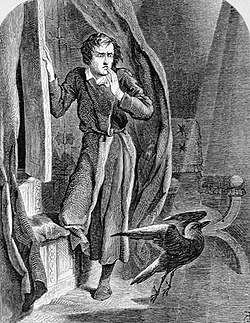"Nevermore." The Raven is the main antagonist from the Edgar Allan Poe's poem titled of the same name. Poe describes in "The Philosophy of Composition" the methods he employed in composing "The Raven." According to the essay, Poe first determined the proper length of the poem, about one hundred lines, to sustain the excitement and allow reading in one sitting. Then he selected the impression to be conveyed, that of Beauty (which he defined not as a quality but as the elevating effect on the soul of contemplating the "beautiful"), and the poetical tone of melancholy.
Overview[]

1858 illustration for "The Raven" by the British artist John Tenniel.
For artistic effects, he wished to use a refrain. In order to allow variation in the application of the refrain, he required a single word - preferably containing the long o, a sonorous vowel, in connection with r as the most producible consonant. He selected "Nevermore" as fitting both the sound and the melancholy tone desired. Having selected the word, Poe then had to come up with a pretext for the continuous use of the word. The idea came to him to use a non-reasoning creature capable of speech, and the Raven was his natural choice in keeping with the intended tone. Next addressing the topic of the poem, Poe reasoned that the most poetical of melancholy topics must closely ally itself to Beauty, and therefore concluded that the death of a beautiful woman was the most poetical topic in the world. It then followed that the poem should be narrated by a bereaved lover. By having the Raven repeat "Nevermore" in answer to the questions posed by the lover, Poe saw the opportunity to make the queries progressively more serious, reflecting the changes in the narrator's state of mind as he indulges in self-torture.
Then Poe proceeded to establish the climax; the ultimate query to which the reply of "Nevermore" should cause the utmost amount of sorrow and despair. In composing the concluding stanza first, Poe was also able to settle the rhythm, meter, and the structure of the stanzas. With the denouement in place, he then went back to set the location and the manner of introducing the Raven to the protagonist. He preferred the confinement of a chamber to an outdoor setting, and so made the night tempestuous to account for the Raven's seeking admission. In calculated contrast, he gave early stanzas an air of the fantastic, before turning the tone serious leading to the climax.
Having completed the narrative, Poe then added the last two stanzas to elevate the poem artistically, giving it the undercurrent of meaning. He points out that "from out my heart" is the first metaphorical expression employed in the poem, and that the Raven is shown, in the very last line, to have become the emblem of mournful, never-ending Remembrance.
